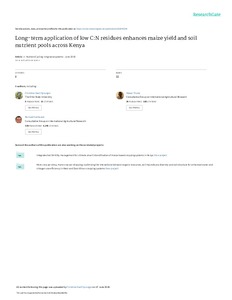| dc.contributor.author | Sprunger, C.D. |
| dc.contributor.author | Culman, S.W. |
| dc.contributor.author | Palm, C.A. |
| dc.contributor.author | Thuita, M. |
| dc.contributor.author | Vanlauwe, B. |
| dc.date.accessioned | 2019-12-04T11:34:03Z |
| dc.date.available | 2019-12-04T11:34:03Z |
| dc.date.issued | 2019-06-05 |
| dc.identifier.citation | Sprunger, C.D., Culman, S.W., Palm, C.A., Thuita, M. & Vanlauwe, B. (2019). Long-term application of low C: N residues enhances maize yield and soil nutrient pools across Kenya. Nutrient Cycling in Agroecosystems, 114, 261–276 |
| dc.identifier.issn | 1385-1314 |
| dc.identifier.uri | https://hdl.handle.net/20.500.12478/5878 |
| dc.description.abstract | Declines in soil fertility and limited access to inorganic nitrogen (N) fertilizer constrain crop production in Sub-Saharan Africa. The incorporation of organic residues could increase nutrient mineralization and replenish soil carbon (C), however, the effect that long-term residue management (10+ years) has on maize (Zea mays L.) yields and soil nutrient pools (C and N) is largely unknown. In four identical long-term trials in Kenya that differ by soil type and climate, we compared maize yield and soil C (0–0.15 m) across four treatments comparing organic inputs of contrasting C:N ratios: tithonia [Tithonia diversifolia (Hemsl.) A. Gray] + N (120 kg N ha−1); tithonia − N (0 kg N ha−1); maize stover + N (120 kg N ha−1); maize stover − N (0 kg N ha−1). On average, maize yields were 92% greater under tithonia compared to maize stover at the sandy sites and in general followed this trend: tithonia + N > tithonia − N = stover + N > stover − N. The continuous application of tithonia also increased soil C and N pools; for instance, mineralizable C was up to 57% greater than that of maize stover at the sandy sites. Increases in yield and nutrient pools under tithonia were less apparent at the clay sites. When exploring the relationship between soil C and maize yield, we found that both mineralizable and processed pools were related to agronomic performance. Our findings demonstrate that low C:N residues could significantly benefit crop production and enhance soil organic matter at sandy sites across Kenya. |
| dc.format.extent | 261-276 |
| dc.language.iso | en |
| dc.rights | Copyrighted; all rights reserved |
| dc.subject | Maize |
| dc.subject | Crop Production |
| dc.subject | Soil Organic Matter |
| dc.subject | Nutrients |
| dc.subject | Cycling |
| dc.subject | Agroecosystems |
| dc.subject | Soil Fertility |
| dc.subject | Africa South Of Sahara |
| dc.title | Long-term application of low C:N residues enhances maize yield and soil nutrient pools across Kenya |
| dc.type | Journal Article |
| dc.description.version | Peer Review |
| cg.contributor.crp | Agriculture for Nutrition and Health |
| cg.contributor.crp | Maize |
| cg.contributor.crp | Roots, Tubers and Bananas |
| cg.contributor.crp | Grain Legumes |
| cg.contributor.affiliation | Ohio State University |
| cg.contributor.affiliation | International Institute of Tropical Agriculture |
| cg.coverage.region | Africa |
| cg.coverage.region | East Africa |
| cg.coverage.country | Kenya |
| cg.creator.identifier | Moses Thuita: 0000-0002-6731-9492 |
| cg.creator.identifier | bernard vanlauwe: 0000-0001-6016-6027 |
| cg.researchtheme | NATURAL RESOURCE MANAGEMENT |
| cg.isijournal | ISI Journal |
| cg.authorship.types | CGIAR and advanced research institute |
| cg.iitasubject | Natural Resource Management |
| cg.journal | Nutrient Cycling in Agroecosystems |
| cg.howpublished | Formally Published |
| cg.accessibilitystatus | Limited Access |
| local.dspaceid | 105788 |
| cg.targetaudience | Scientists |
| cg.identifier.doi | https://dx.doi.org/10.1007/s10705-019-10005-4 |

